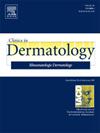Characteristics and career outcomes of dermatology-focused medical student research grant recipients
IF 2.3
4区 医学
Q2 DERMATOLOGY
引用次数: 0
Abstract
Although several dermatology-focused research grants for medical students exist, studies have yet to evaluate the outcomes of grant recipients, such as entry into dermatology residency and academic careers. We have described the characteristics of recipients of dermatology-focused medical student research grants and outcomes, including entry into dermatology residency and academic careers, and we have focused on seven dermatology-focused national and regional research grants eligible for US medical students. Data were obtained from publicly available online sources for grants from 2004 to 2023. Of the 235 medical student recipients of dermatology research grants between 2004 and 2023, 45.5% attended one of the top 20 medical schools funded by National Institutes of Health research grants. Of those who completed medical school, 68.3% advanced to a dermatology residency (n = 123/180). Among board-certified dermatologists, 44.7% held an academic position (n = 34/76); among those who attended a top 20 medical school, 50% held an academic position (n = 23/46) compared with 36.7% who did not (n = 11/30). Limitations of this study include selection bias and incomplete data availability. Medical student research grants allow students to thoughtfully engage in dermatology research early in medical education. These grants may facilitate entry into dermatology residency and academic careers and lead to continued research endeavors.
以皮肤病学为重点的医学生研究补助金获得者的特征和职业成果。
虽然目前已有几项针对医学生的皮肤病学研究补助金,但尚未有研究对补助金获得者的成果(如进入皮肤病学住院实习和学术生涯)进行评估。我们描述了以皮肤病学为重点的医学生研究补助金获得者的特征和结果,包括进入皮肤病学住院医师培训和学术生涯,并重点研究了符合美国医学生资格的七项以皮肤病学为重点的国家和地区研究补助金。我们从网上公开获取了 2004 年至 2023 年的研究基金数据。在 2004 年至 2023 年期间获得皮肤病学研究基金的 235 名医学生中,45.5% 就读于美国国立卫生研究院研究资助的前 20 所医学院之一。在完成医学院学业的学生中,68.3%升入皮肤科住院医师培训机构(人数=123/180)。在获得委员会认证的皮肤科医生中,44.7%的人担任学术职务(人数=34/76);在就读于排名前20的医学院的医生中,50%的人担任学术职务(人数=23/46),而没有担任学术职务的人占36.7%(人数=11/30)。本研究的局限性包括选择偏差和数据不完整。医学生研究补助金允许学生在医学教育早期就深思熟虑地参与皮肤病学研究。它们可以帮助学生进入皮肤科住院医师培训和学术生涯,并促使他们继续从事研究工作。
本文章由计算机程序翻译,如有差异,请以英文原文为准。
求助全文
约1分钟内获得全文
求助全文
来源期刊

Clinics in dermatology
医学-皮肤病学
CiteScore
4.60
自引率
7.40%
发文量
106
审稿时长
3 days
期刊介绍:
Clinics in Dermatology brings you the most practical and comprehensive information on the treatment and care of skin disorders. Each issue features a Guest Editor and is devoted to a single timely topic relating to clinical dermatology.
Clinics in Dermatology provides information that is...
• Clinically oriented -- from evaluation to treatment, Clinics in Dermatology covers what is most relevant to you in your practice.
• Authoritative -- world-renowned experts in the field assure the high-quality and currency of each issue by reporting on their areas of expertise.
• Well-illustrated -- each issue is complete with photos, drawings and diagrams to illustrate points and demonstrate techniques.
 求助内容:
求助内容: 应助结果提醒方式:
应助结果提醒方式:


